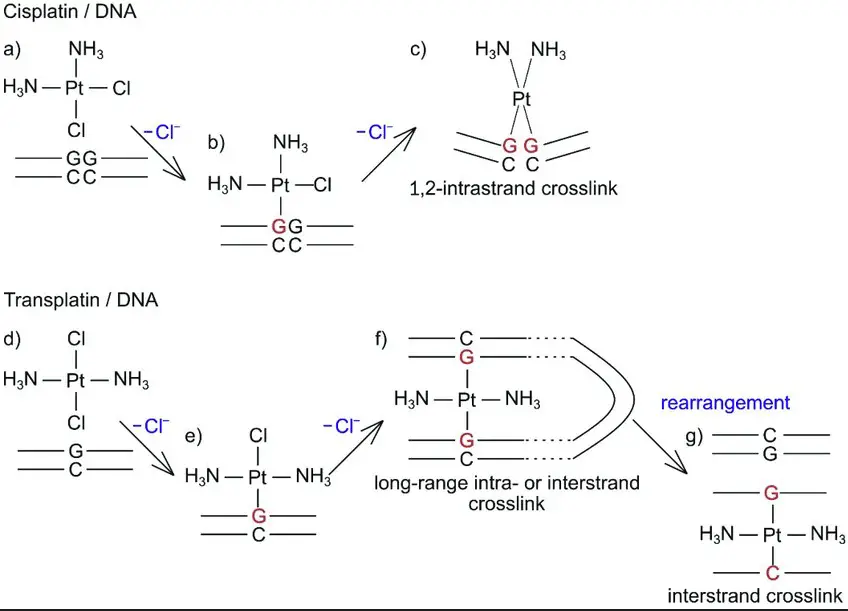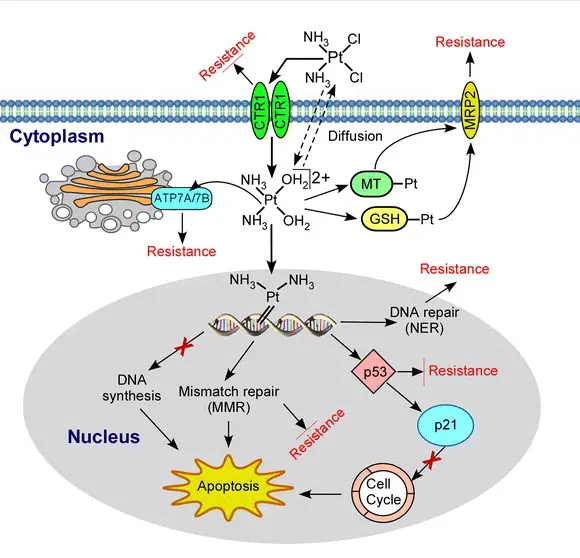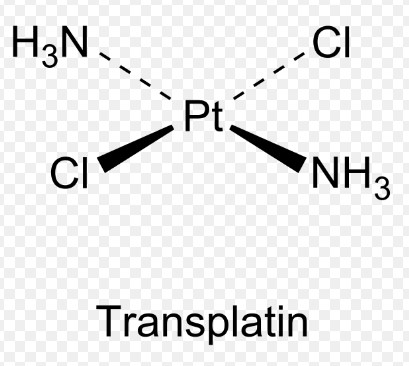Platinum-based chemotherapy marks a cornerstone in the fight against cancer, leveraging metals to target and destroy malignant cells. Among these potent agents, cisplatin and transplatin emerge as significant compounds, each playing a pivotal role in oncological treatments. Their discovery and application have revolutionized the approach toward cancer therapy, offering hope and a chance for survival to many.
The primary difference between cisplatin and transplatin lies in their molecular geometry and the consequent impact on their biological activity. Cisplatin, characterized by its cis-geometry, has been widely recognized for its efficacy in treating various types of cancers, including testicular, ovarian, and bladder cancer. In contrast, transplatin, with its trans-arrangement, exhibits markedly different biological activities and is less commonly used in clinical settings due to its lower effectiveness against cancer cells.
Both compounds operate by binding to DNA in cancer cells, but the arrangement of their molecules dictates their ability to form cross-links with DNA and, therefore, their effectiveness in triggering cell death. Cisplatin forms more effective cross-links that prevent cancer cells from replicating, leading to cell death. In contrast, transplatin’s interactions with DNA are less effective at inducing the same lethal outcome. This distinction underscores the importance of molecular structure in determining the therapeutic potential of platinum-based chemotherapy agents.

Platinum-Based Chemotherapy
Overview
Platinum-based chemotherapy represents a major class of cancer treatment that uses platinum compounds to attack cancer cells. These treatments are known for their effectiveness in damaging the DNA of cancer cells, which inhibits their ability to divide and grow. The use of platinum-based agents in chemotherapy has been a significant advancement in the fight against cancer, offering hope to patients with various types of malignancies.
Key Components
Among the platinum-based compounds, cisplatin and transplatin stand out as key components. While cisplatin has become a staple in the treatment of several cancers, transplatin is less commonly used but remains an important subject of research. Each has unique properties and mechanisms of action, contributing differently to the field of oncology.
Cisplatin
Discovery and History
Cisplatin was discovered accidentally in the 1960s by Barnett Rosenberg, who was studying the effects of electric fields on bacterial growth. He noticed that platinum electrodes used in his experiments were inhibiting cell division, leading to the identification of cisplatin as a potential anticancer agent. This discovery marked the beginning of its journey as a revolutionary chemotherapy drug.
Mechanism of Action
Cisplatin works by forming cross-links with the DNA in cancer cells. These cross-links prevent DNA from unwinding and duplicating, which is a necessary step for cell division. By interfering with DNA replication, cisplatin causes cancer cells to undergo apoptosis, or programmed cell death, thereby reducing the tumor size and spread.
Uses and Effectiveness
Cisplatin is effective against a wide range of cancers, including but not limited to ovarian, testicular, and lung cancer. Its success rate varies depending on the type of cancer, stage at diagnosis, and combination with other treatments. In many cases, cisplatin is used as part of a combination therapy, enhancing its effectiveness.
Side Effects and Challenges
While cisplatin is a powerful cancer-fighting drug, it comes with a range of side effects. Common issues include nausea, vomiting, kidney damage, and neurotoxicity. Moreover, some cancers develop resistance to cisplatin, making it less effective over time and posing significant challenges in treatment.
Transplatin
Discovery and History
Transplatin, the isomer of cisplatin, was discovered following the recognition of cisplatin’s anticancer properties. Researchers sought to understand the structural differences between the two and their implications for cancer treatment. Unlike its counterpart, transplatin has not found widespread use in clinical settings, primarily due to its reduced efficacy in killing cancer cells.
Mechanism of Action
The key difference in the action of transplatin compared to cisplatin lies in its ability to bind with DNA. Transplatin forms trans-configured cross-links with DNA, which are less effective at preventing cancer cells from replicating. This difference in binding affects its overall usefulness as a cancer treatment.
Therapeutic Use
The current research on transplatin focuses on its potential uses and how it can be modified or combined with other treatments to enhance its effectiveness. Although not as widely used as cisplatin, understanding transplatin’s mechanism offers insights into developing new platinum-based therapies with improved outcomes and fewer side effects.
Side Effects and Limitations
Transplatin shares some side effects with cisplatin, such as nausea and kidney issues, but its lesser effectiveness means it’s not the first choice in treatment. The limitations in its action against cancer cells have driven ongoing research into how it can be adapted or improved for better therapeutic use.

Comparative Analysis
Chemical Structure
The key distinction between cisplatin and transplatin lies in their molecular structure, which directly impacts their function and effectiveness. Cisplatin contains two chloride atoms and two ammonia groups positioned adjacently (in a cis configuration), forming a square planar structure. This arrangement allows for effective binding with DNA, facilitating the formation of cross-links that inhibit DNA replication and lead to cancer cell death.
In contrast, transplatin has a similar composition but with the chloride atoms and ammonia groups positioned opposite each other (in a trans configuration). This structural difference significantly reduces its ability to form cross-links with DNA in the same way as cisplatin, rendering it less effective in disrupting cancer cell replication.
Efficacy in Cancer Treatment
The efficacy of cisplatin and transplatin in cancer treatment is deeply influenced by their molecular structures. Cisplatin’s ability to form cross-links more efficiently makes it a potent drug for treating a variety of cancers, including ovarian, lung, and testicular cancer. Its clinical success has established it as a cornerstone of chemotherapy regimens across the globe.
Transplatin, however, due to its less effective DNA binding, shows a markedly lower efficacy in cancer treatment. Its use is more limited, with ongoing research focusing on how its structure could be modified or how it could be used in combination with other treatments to enhance its anticancer properties.
Side Effects Profile
Both cisplatin and transplatin are associated with side effects, but their profiles differ due to their differing efficacies and mechanisms of action. Common side effects of cisplatin include kidney damage, nausea, vomiting, and neurotoxicity. These can often be severe and limit the dosage that can be safely administered to patients.
Transplatin, while also causing side effects such as nausea and kidney issues, is generally less toxic than cisplatin. However, its reduced efficacy as an anticancer agent means it’s not a preferred choice in clinical settings, which naturally leads to its side effects being less of a primary concern in current medical practice.
Resistance Mechanisms
Resistance to chemotherapy drugs like cisplatin and transplatin is a significant challenge in cancer treatment. Cancer cells can develop resistance through various mechanisms, including increased repair of DNA damage, reduced drug uptake, and enhanced detoxification processes. This resistance not only diminishes the drugs’ efficacy but also complicates treatment regimens.
Research into overcoming this resistance is ongoing, with studies exploring combination therapies, drug modifications, and the use of inhibitors that target specific resistance mechanisms. This area remains a critical focus, as improving the effectiveness of cisplatin and transplatin against resistant cancer cells could significantly enhance patient outcomes.
Future Perspectives
Research Directions
The future of platinum-based chemotherapy lies in the ongoing research aimed at enhancing the efficacy and reducing the side effects of these drugs. Scientists are exploring several avenues, including the development of new platinum compounds that maintain the anticancer potency of cisplatin with reduced side effects, and modifying existing drugs to overcome resistance mechanisms.
Another promising research direction is the use of targeted delivery systems that could direct these drugs more precisely to cancer cells, minimizing damage to healthy tissues and reducing side effects.
Alternative Treatments
As the field of oncology evolves, alternative treatments beyond platinum-based chemotherapy are gaining traction. These include targeted therapy, which involves drugs or other substances that specifically target cancer cells with minimal harm to normal cells, and immunotherapy, which boosts the body’s natural defenses to fight the cancer.
Gene therapy and nanotechnology are also emerging as innovative approaches to cancer treatment, offering new ways to target and destroy cancer cells with unprecedented precision. These advancements, combined with traditional treatments, promise a more effective and patient-friendly approach to cancer care in the future.
Frequently Asked Questions
How do cisplatin and transplatin work?
Cisplatin and transplatin target cancer cells by binding to their DNA, interfering with the cell’s replication process. Cisplatin, due to its cis-configuration, is more effective at forming DNA cross-links, leading to cell death. Transplatin, while similar, is less efficient in forming these cross-links due to its trans-configuration, resulting in reduced effectiveness as a cancer treatment.
Why is cisplatin more commonly used than transplatin?
Cisplatin’s widespread use in chemotherapy is attributed to its higher efficacy in treating various cancers, such as testicular, ovarian, and bladder cancer. Its ability to form cross-links with DNA more effectively than transplatin results in better outcomes for patients. Transplatin’s lower effectiveness in inducing cancer cell death limits its use in clinical settings.
Are there any ongoing researches on improving transplatin’s efficacy?
Yes, there is ongoing research aimed at enhancing transplatin’s therapeutic effectiveness. Scientists are exploring modifications to its molecular structure to improve its ability to form DNA cross-links and exploring combination therapies that might augment its cancer-fighting capabilities. These studies hold promise for expanding the utility of platinum-based chemotherapies in the future.
Conclusion
In the realm of cancer treatment, the distinction between cisplatin and transplatin encapsulates the intricate balance between molecular structure and therapeutic efficacy. Cisplatin’s success story in oncology underscores the importance of chemical configuration in drug design and effectiveness, offering a blueprint for the development of future cancer therapies.
As research continues to unravel the complexities of platinum-based chemotherapy, the potential for refining and enhancing these powerful agents grows. The journey from understanding their fundamental differences to harnessing their full potential is pivotal, promising more effective and targeted approaches to cancer treatment. The story of cisplatin and transplatin is not just one of molecular differences but a testament to the relentless pursuit of life-saving innovations in the battle against cancer.

